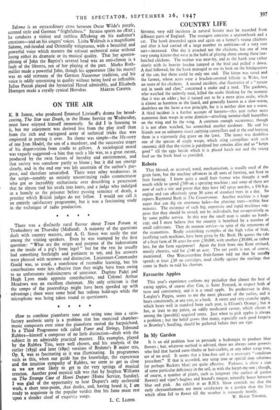ON THE AIR
K. B. INDOE, who produced Emanuel Litvinoff's drama for broad- casting, The Star was Death, in the Home Service on Wednesday, must have enjoyed himself immensely. So did I in listening to it, but my enjoyment was derived less from the play itself "than from the rich and variegated array of technical tricks that was employed in putting it over. Its theme was simple—the life-story of one Jean Model, the son of a murderer, and the successive stages of his degeneration from cradle to gallows. A sociological moral was vaguely suggested—a hint that such a life was, to a great extent, produced by the twin factors of heredity and environment, and that society was somehow partly to blame ; but it did not emerge clearly, and in the end one was left uncertain of the author's pur- pose, and therefore unsatisfied. There were other weaknesses in the script—notably an entirely unconvincing radio commentator who got so incredibly enthusiastic over describing a procession that he almost tied his uvula into knots, and a judge who indulged in a homily to the prisoner before passing sentence of death, a practice which British judges do not follow. I would not call it an entirely satisfactory programme, but it was a fascinating study in the technique of radio production.
There was a distinctly rural flavour about Town Forum at Tewkesbury on Thursday (Midland). A majority of the questions dealt with country matters, and A. G. Street was easily the star among the visiting speakers. Even he was stumped by the first question: " What are the origin and purpose of the indentations on the inside of a pig's front legs? " but for the rest he usually had something forthright and pertinent to say, and his answers were phrased with neatness and distinction. Lieutenant-Commander Gould was, as usual, a storehouse of recondite learning, but his contributions were less effective than they might have been owing to an unfortunate indistinctness of utterance. Daphne Padel and Hugh Lyon made apposite contributions, and Colonel Arthur Meadows was an excellent chairman. My only criticism is that the tempo of the proceedings might have been speeded up with advantage ; there were some brief but tedious hold-ups -while the microphone was being taken round to questioners.
How to combine pianoforte tone and string tone into a satis- factory aesthetic unity is a problem that has exercised chamber- music composers ever since the pianoforte ousted the harpsichord. In a Third Programme talk called Piano and Strings, Edmund Rubbra—himself a composer of no little distinction—dealt with the subject in an admirably practical manner. His examples, played by the Rubbra Trio, were well chosen, and his analysis of the earlier (1859) and later (1891) versions of Brahms's B major trio, Op. 8, was as fascinating as it was illuminating. In programmes such as this, when our guide has the knowledge, the experience and the intuitive sympathy of Rubbra, we seem to get as close as we are ever likely to get to the very springs of musical creation. Another good musical talk was that by Stephen Williams on The Strange Case of Henri Duparc (Home Service, Sunday). I was glad of the opportunity to hear Duparc's only orchestral work, a short tone-poem, Aux itailes, and, having heard it, I am ready to acquiesce in the popular verdict that his fame must rest upon a slender sheaf of exquisite songs. L. C. LLOYD.


































 Previous page
Previous page